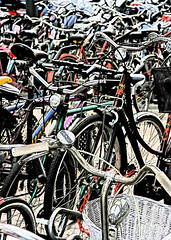The New York Times Freakonomics folks had an interesting run down of studies on cycling safety a couple of days ago, under the title Will Bicycling to Work Get You Killed?. Timely considering another recent fatality here on the West Coast.
The intuitive answer is that the more riders there are, the higher the chances of a fatality. The article sites a counter-intuitive result from the Safety in Numbers study (Full text): “An individual’s risk while [cycling] in a community with twice as much [cycling] will reduce to 66%”.
Weirdly, the Freakonomics article morphs this study (and a few other links) into a discussion of cyclists obeying traffic laws and helmets. The cited study actually draws a very different conclusion: more pedestrians or cyclists cause motorists to behave differently.
It seems unlikely that people walking or bicycling obey traffic laws more or defer to motorists more in societies or time periods with greater walking and bicycling. Indeed it seems less likely, and hence unable to explain the observed results. Adaptation in motorist behavior seems more plausible and other discussions support that view.
The Pucher study noted in the Freakonomics article looks into the methods used in the Netherlands and Germany to improve cycling safety. Almost all of the methods noted improve infrastructure or law enforcement:
- Better Facilities for Walking and Cycling
- Traffic Calming of Residential Neighborhoods
- Urban Design Oriented to People and Not Cars
- Restrictions on Motor Vehicle Use
- Traffic Education
- Traffic Regulations and Enforcement
Maybe I missed it, but I really didn’t see much information in the cited articles about how helmets or cyclist behavior was involved in improving safety. I’m all for education and safety equipment, but I’m always amazed at how the media discussion tends towards pushing responsibility for safety away from infrastructure and motorists.
The only mention of modifying cyclist behavior in the studies is Pucher’s note about traffic education for motorists and non-motorists. In addition to encouraging motorists to be aware of non-motorists, children overseas are routinely educated in defensive behavior when dealing with traffic. Genius, I say.
The Jacobsen and Pucher studies were published about the same time, so it’s easy to see how they failed to influence each other. From my point of view, Pucher et al could have added another item to their list: More cyclists in the Netherlands and Germany made all those cyclists safer.
The other cool thing here? Getting your spouse, friend, or evil arch enemy to ride makes you both safer. All the more reason to get everybody out riding. Bring on the bike busses!
…We're riding townies, adventure, and mountain bikes. Find recommendations on our store page. As Amazon Associates we earn from qualifying purchases.
